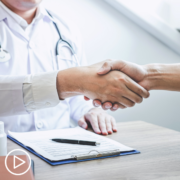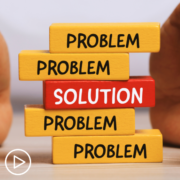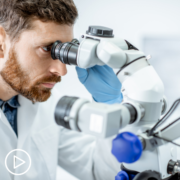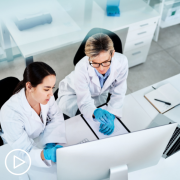Why Is Shared Decision-Making Important for AML Patients?
Why Is Shared Decision-Making Important for AML Patients? from Patient Empowerment Network on Vimeo.
What makes shared decision-making vital for acute myeloid leukemia (AML) patients? Expert Dr. Andrew Hantel from Dana-Farber Cancer Institute and Harvard Medical School discusses his approach to shared decision-making, the roles of patients and families, and proactive patient advice for the practical side of treatment risks and benefits.
[ACT]IVATION TIP
“…when your doctor’s talking to you about the risks and benefits of a treatment…ask them to talk to you about what does this mean in terms of maybe getting towards a milestone that you want to be around for and also we’ll be able to go to in terms of how healthy you are, side effects you might have, need to be in the hospital, all those different kind of things that I think are easy to get lost when we see somebody either in a hospital bed or in a clinic room that’s kind of spaced away from where they are and where they live all of their life.”
Download Resource Guide | Descargar guía de recursos
Related Resources:
Transcript:
Lisa Hatfield:
Dr. Hantel, how do you involve your patients and families in the shared decision-making process?
Dr. Andrew Hantel:
So shared decision-making is a complex subject, and I think the first thing I always like to do is to really just start off the conversation as much as we can. Just asking the person about who they are, who their loved ones are, what’s important to them. I think setting up the conversation that way really dictates a lot of the decisions that get made, because it helps me kind of understand who’s coming in to see me, what they find important in life, kind of what their goals are for their life, and for the people around them. Sometimes people are very much talking about grandkids and things that they want to see when the grandkids get older. Sometimes it’s that the person themselves is young and really wants to live to have their grandkids.
And so I think that this kind of breadth of people who can come in with leukemia means that I just need to know more about the person even before talking about the disease that they’re there to see me for. When we get into the leukemia itself, it’s really contextualizing a lot of the information that we find out about their leukemia with what I just said with the person themself and what their values are.
And this can take the form of many different things because in leukemia, we have treatments that are more intense, that are less intense. We have options like bone marrow transplant for some patients when it’s necessary. And a lot of those things are balances between risks that people might need to accept in terms of the side effects from treatments and the benefits that those treatments will give them in terms of our expectation of putting leukemia into a remission or ideally curing them long-term of their disease.
And so the patients and families are essential in that process, because they’re the ones who in the end are going to make the decision about, “Do I want this therapy or not? Do I want to move forward with something that’s going to make me have to be in the hospital for several weeks or longer, potentially, or try something outpatient if those options are available to me and kind of where I want to spend my time?” And so in that, it’s really just an ongoing conversation. It can take so many forms that we just want to know the specifics of what the risks and benefits are and what those risks and benefits actually mean for that person in front of me.
Lisa Hatfield:
Okay. Thank you. And do you have an activation tip for patients, their families maybe about when they come in to visit you for an office visit regarding those decisions?
Dr. Andrew Hantel:
So my activation tip would be for when your doctor’s talking to you about the risks and benefits of a treatment, it’s very easy for us to talk about risks and benefits in medical terms in terms of percentages of this and percentages of that. And you know I think it would be better if you ask and ask them to talk to you about what does this mean in terms of maybe getting towards a milestone that you want to be around for and also we’ll be able to go to in terms of how healthy you are, side effects you might have, need to be in the hospital, all those different kind of things that I think are easy to get lost when we see somebody either in a hospital bed or in a clinic room that’s kind of spaced away from where they are and where they live all of their life. And so I would just say bring in and ask for kinds of risks and benefits and decisions that are around who you are as a person even in addition to kind of the medical facts and their ability to tell you that.
Lisa Hatfield:
Great. Thank you. I love that tip personally, I’m going to use that when I see my oncologist in two weeks to have a milestone to work toward maybe, or based around. So thank you for that tip.













